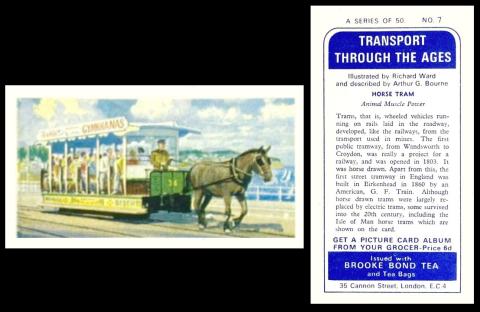
Here we have "riding a tram" . And if anyone out there has the much scarcer red backed Musgrave version of this card do send us a scan of front and back and I will happily replace this - giving your name or alias if you like as well.
The first ever tram, worldwide, was much like the one on this card, operated by a horse; it was known as the Swansea and Mumbles Railway and it first plied its trade in 1807. It closed in the early 1960s.
Horses were soon seen as old fashioned, and there was a limit on how long they could work, so they were phased out in many places in favour of steam and then electricity. In some places a cable system was operated, hauling the cars along. This seems to have worked very well on slopes, hence the San Francisco Cable Car. Electric trams needed another form of cable, and a lot of these were delivered overhead, this is the system which is still used at Blackpool.
For some reason trams were not seen as a way forward and many were removed. Manchester was the first to get rid of its trams entirely in 1949, and replace them with buses. Other users took advantage of owning a car. Then things started to change as we became more aware of the climate and how we were changing it. Parking was also impossible. The first new trams were built in Europe, and became very popular. We opened our first tramway system in 1980, when the Tyne and Wear Metro opened. And seven years later trams returned to London, with the Docklands Light Railway.
This is the original blue back card, which was issued with Brooke Bond tea in 1966. The official Brooke Bond reference number for it is B.16. Then there was a black backed version, this was not issued with the tea, it was reprinted officially by Brooke Bond in 1973 in order to supply sets of cards that had gone out of print. These black backed sets were sold to collectors through the order forms that appeared in the centre of each album.
There was a wallchart and an album for the original set. The album can be found in three versions, which is somewhat odd. The difference seems to involve the order form, which is printed in red. It seems that at some time the tag on that form was shifted from being on the left hand side to the right hand side. However the third version has no tag, and that is because it was not issued in an album, it was sent back with your purchase by Brooke Bond so that you could buy something else if you so desired.
The HX.158 and D.413 codes tell us that this set was also issued by another manufacturer and that was Musgrave Brothers Limited, Tea Blenders of Cornmarket Street in Cork. They were founded in 1876 and are actually still going very strong, in fact they are Ireland`s biggest grocer, and they also operate in Spain. They apparently also used to own Budgens and Londis. Their cards can easily be told from Brooke Bond because the Musgrave versions have reddish-mauve backs, or at least these and the Butterflies do. Musgrave made quite a habit out of re-issuing cards that other manufacturers also produced, and in fact they also issued other Brooke Bonds, these being British Birds by Frances Pitt, British Wildlife, and Butterflies of the World. Other sets that sound like they might be Brooke Bonds turn out not to be (especially Tropical Birds and Wild Flowers). This set was issued in the same year as the Brooke Bond version, 1966, and the album for it - and possibly the others - has the word "Musgrave" on the cover.
